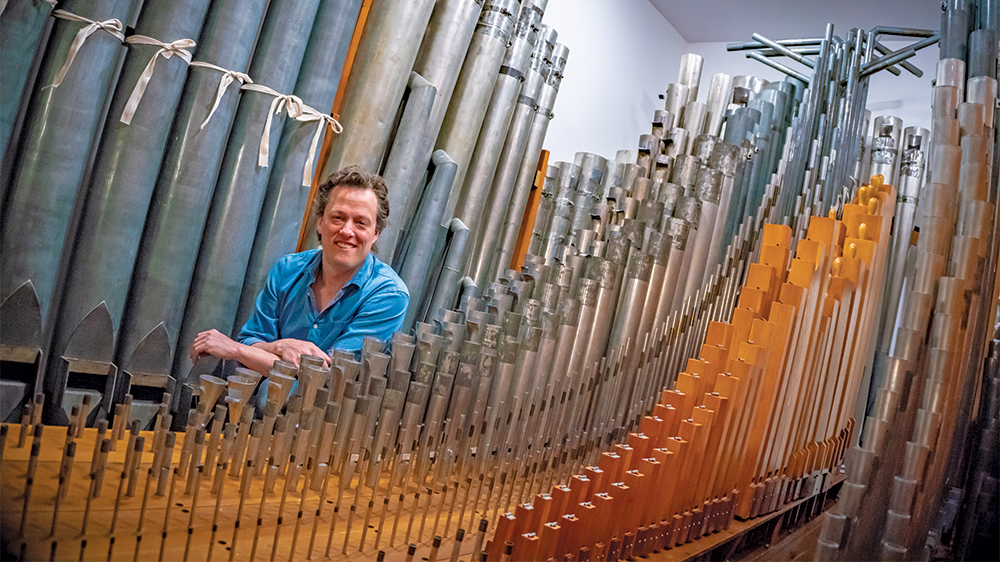Composer Builds Scoring Stage Just for Classic Wurlitzer Pipe Organ
By Jon Burlingame
LOS ANGELES (Variety.com) – When composer Nathan Barr found the instrument he had been looking for, he built a studio for it.
Barr (“True Blood,” “The Americans”) collects unusual musical devices, especially mechanical ones from the early 20th century. His search for a theater organ started when he scored “Hemlock Grove,” a Netflix horror series that earned him his first Emmy nomination. Five years ago, he discovered an old Wurlitzer pipe organ in floor-to-ceiling crates in a warehouse in Reno, Nev. The organ had occupied the scoring stage at 20th Century-Fox; you can hear its grand and powerful sounds in such classic scores as Bernard Herrmann’s “Journey to the Center of the Earth,” Jerry Goldsmith’s “Patton” and John Williams’ “Witches of Eastwick.”
Installed at Fox in 1928, the organ was designed to accompany silent films but remained in use until 1997, when the studio sold it. When Barr bought the instrument, it had been acquired by Ken Crome, an organ expert. Crome and his father had maintained the instrument for decades, dating back to the 1950s. “He had worked on it as a kid and, as many people did, hated when the studio dismantled and sold it,” says Barr.
The composer had long considered adding a small scoring stage to his home studio, but the Wurlitzer demanded a much larger space. A theater organ is not just the visible, horseshoe-shaped console with keyboards and pedals; it’s also 1,500 pipes requiring three chambers of their own, plus sub-chambers to house and quiet the noisier mechanical aspects of vintage versions (a 1928 story in Music Trade Review called the Fox organ a Wurlitzer Orchestral-Cathedral model).
Barr found a building in Tarzana he could turn into a recording studio, rebuilt specifically to house the Wurlitzer: The 8,000-square-foot Bandrika Studios (named after the fictional country in Hitchcock’s “The Lady Vanishes,” a Barr favorite) has a 1,500-square-foot recording stage that can accommodate 50 to 60 musicians.
The restoration process has taken four years and likely cost in the hundreds of thousands of dollars (Barr declines to say). Yet, he adds, Fox maintained the organ so well that “you rarely see pipework that looks so extraordinary. This has got to be one of the most well-kept, beautiful Wurlitzers left in the world.”
Pasadena theater organist Mark Herman agrees. “This is a very special instrument,” he tells Variety. “Ken Crome obviously had to restore everything, but it’s one of the cleanest and most beautiful theater-organ restorations I’ve ever seen.”
Herman calls the clarity of the instrument unparalleled. “The way it speaks out of the chambers, with nothing impeding the sound, into a room with really fine acoustics, makes it the ideal studio instrument,” he says.
Because it was manufactured near the end of the silent-movie era, the organ was designed to provide the performer with a wide range of sounds — from simulating orchestral instruments (strings, woodwinds, brass) to percussion (drums, marimba, chimes) and even sound effects (sirens, fire bells, horses’ hooves, birdcalls).
“The whole point was to give one person, sitting at the organ, maximum ability to complement a silent film,” Barr explains. The console has three keyboards and is connected to a nearby upright piano — a 1929 Wurlitzer model that was once part of the Portland, Ore., Paramount Theatre — making pure piano sounds possible too.
Barr called in one of the world’s most respected recording engineers, Peter Cobbin (formerly director of engineering at London’s Abbey Road studio), to tweak and hone the acoustics of the room. Cobbin says he was “in awe of the colors, the timbres, the possibilities of such a magnificent instrument” and praises Barr for his vision and commitment to building an acoustic stage.
Cobbin was at the mixing board for the late-May recording sessions — involving both the organ and a small string section — for Barr’s score to “The House With a Clock in Its Walls,” billed as a “gothic horror fantasy comedy.” The Sept. 21 release will mark the organ’s 21st-century debut for movie audiences.
“Today, some type of MIDI keyboard is often used with many electronic manipulations to make the sounds of the pipe organ,” notes Richard Neidich, chairman of the board of the American Theatre Organ Society. “Nathan’s studio will be able to reproduce scores that have not been possible for more than 30 years [with] pure organ or, more likely, orchestra and organ.”
Ladd Thomas, who played the instrument on many occasions at Fox, including for Jerry Goldsmith’s “Star Trek: The Motion Picture” and John Williams’ “Home Alone” scores, says he’s thrilled that audiences will hear it again. “It’s a landmark organ of that era,” he explains.
Barr says he’ll use the new recording stage primarily for his own projects. “Given how particular and unusual this space is, I don’t envision this ever becoming a commercial operation,” he says. “But certainly there will be many who record here in the years to come, and many collaborations.
“I want to do salon concerts,” he adds — just one of many ideas floating around at the moment. He envisions playing silent Harold Lloyd comedies with organ accompaniment, “and with all sorts of other instruments.”
The composer remains fascinated by the technology that went into the creation of the instrument. “Sometimes it’s not even about the sound they make,” he says. “It’s about the history and ingenuity of it, the aesthetics of it — it’s all one big package.”

